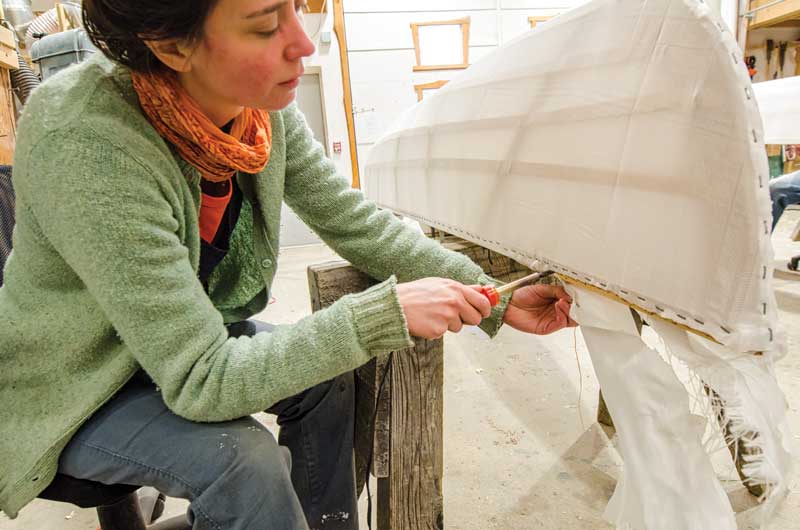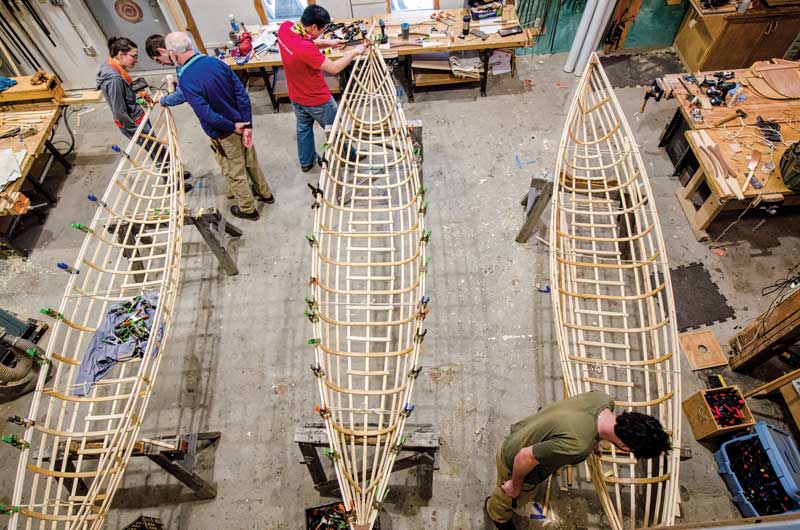 Meghan Vigeant uses a soldering iron to trim excess fabric from the skin-on-frame canoe that she built at Yestermorrow.
Meghan Vigeant uses a soldering iron to trim excess fabric from the skin-on-frame canoe that she built at Yestermorrow.
Photographs by Michael Riddell
I have been seeking membership into the Club of People Who Build Things With Their Hands for as long as I can remember. Oh, to join the ranks of guys and gals who know how to make furniture from scrap wood, engineer solar dehydrators, and use pneumatic drills underwater to restore old boats just for fun. Self-sufficient badasses. Kings and queens of DIY. Those I’ve come to recognize as the average Mainer.
I’ve applied to the club before. During my college days I worked in a theater shop. We’d spend months building a set for a play, and then, with crowbars in hand and hammers dangling from a belt, we’d tear it all down in one night with great relish. I also volunteered with Habitat for Humanity to build houses in Florida during spring break. I was the assistant who caught the 2x4 as it came off the table saw, the one who held the wood stable while someone else drilled. The one who admired the tough savvy builder women who could hold their own in the male-dominated world of drills and saws. I was not one of them.
What’s holding me back? One: No tools. I don’t know what kind of tools I need to make a cold frame, or a bookcase, or the tiny house of my dreams. Two: No time. Ugh, there’s never enough time. Three: Despite theater shop and Habitat for Humanity, I still lack knowledge and experience. So, this past winter I signed up for an entire week devoted to building something, access to a dream set of tools, and a course called “Build Your Own Skin-on-Frame Canoe.” Not only would I get to build something, I could take it home with me, and it would be a canoe. A freaking canoe!
 An inside look at the low-seater skin-on-frame canoe. Photo by Meghan VigeantIn late January I drove over the mountains to Yestermorrow, a design and build school in Waitsfield, Vermont. Our class assembled for orientation on a snowy Sunday night: five students, two instructors, and one tall, dark, and handsome apprentice. I was the only gal in the group. Hilary Russel, a connoisseur of hand-built canoes, was our canoe-building guide.
An inside look at the low-seater skin-on-frame canoe. Photo by Meghan VigeantIn late January I drove over the mountains to Yestermorrow, a design and build school in Waitsfield, Vermont. Our class assembled for orientation on a snowy Sunday night: five students, two instructors, and one tall, dark, and handsome apprentice. I was the only gal in the group. Hilary Russel, a connoisseur of hand-built canoes, was our canoe-building guide.
It turns out that a skin-on-frame canoe is an excellent starter project for a beginning boatbuilder, particularly the mathematically un-inclined such as myself. You don’t have to be so exact in your measurements. A smidge of forgiving wiggle room and eyeballing techniques can take you pretty far. Our canoes would not be 100 percent natural, not like a birch bark canoe. They would be made using a combination of traditional woodworking skills, power tools, polyester and polyurethane, some glue, staples, and a few well-placed screws, and a fair amount of artificial sinew.
We began Monday morning by squeezing very rusty, very hard-to-pry-open clamps and securing three or four pieces of wood together at a time—the inwales, gunwales, keel, stringers, deck, and the stem-knee. It took a few days to build up the muscles in my hands, but by day three I was clamping like a champ. We steamed strips of wood and bent it against our own ribs to form the ribs of the canoes. We lashed the stringers and the ribs together with artificial sinew (a polyester string coated in wax). The sinew gradually dug into my skin and I happily took someone’s suggestion to bandage my knuckles with black electric tape. For nearly two solid days I repeated: loop, pull, tighten, cross, cross, surgeon’s knot, surgeon’s knot, regular knot, and trim. It became a meditation. Next came the water-based polyurethane, which smelled like a cross between banana cream pie and fish. We brushed this stuff onto every available surface.
We only had five days to build our canoes. Eager to make use of every spare moment, I found my way back into the shop after dinner and early before breakfast to glue, clamp, and sand important side projects: floorboards, back rests, thwart, and a double-ended paddle. Blowing out blackened boogers into tissue, I realized I really needed to wear a scarf around my nose and mouth when using the sander; turning the automatic vent on helped too. Each night in my room, I creaked my aching body to the floor to stretch, grateful I had brought along my yoga mat, body roller, and Epsom salts for nightly baths. I was learning an important life and boat lesson: by taking care of my body I could take care of my boat, and vice versa. Each morning I woke fresh and elated to get back into the shop to work on my canoe.
 Students at Yestermorrow work on the final stages of the canoe frames. Clamps hold the inwales in place and strings help keep the boat in shape until the thwart and back rests can be inserted.
Students at Yestermorrow work on the final stages of the canoe frames. Clamps hold the inwales in place and strings help keep the boat in shape until the thwart and back rests can be inserted.
My favorite part of building the canoe was skinning it. There was a time when some boatbuilders used animal hide to skin boats: the Irish made Currachs with cowhide, the Inuits stretched walrus and seal skin over their umiaks, while the Welsh skinned their coracles with horse and bullock hide. For our modern-day boat skin Hilary unwrapped packages of white polyester fabric big enough to cover a car. To attach the fabric and make it tight, I first draped the fabric over the frame of the boat and secured it with clamps. Then I sewed the ends of fabric across the open-side of the canoe to make the skin pull tightly against the frame. After the first initial threading, I went along my boat tightening the strings while a friend helped pull the excess string away. I made several tightening rounds, and by the time I’d gone through five or six times, the strings were taught and musical, like plucking a stringed instrument, pling, pling, pling. I spent the last day stapling the fabric to the gunwales with hundreds of staples, drawing a methodical line with a hot iron to burn off the excess fabric, and wielding a heat gun to tighten and smooth the skin like insulating plastic on a window. Lastly, I applied several coats of banana-cream-fishy polyurethane to the skin.
At one point in the middle of the week, I cut myself, nothing big, just a little nick, but enough to shed a few drops of blood on the frame of my boat. I was so proud of those drops. I had marked my boat and the boat had marked me too. By the end of the week I was covered in sawdust, my sweater streaked and my pants speckled in polyurethane, gorilla glue in my hair, and black electric tape decorated my knuckles—a look I proudly wore even in town.
On the last night we each loaded up our canoes onto the tops of our cars in an early February snow flurry, and soon everyone scattered to the winds, back to our regular lives. I felt one-part silly, one-part badass driving around New England with my beautiful self-made canoe on top of my car, as if I had intentions of canoeing in early February.
Back home in Maine my skin-on-frame canoe waited for spring in the garage, lit like a giant paper lamp by a single bulb. I showed it off to anyone who came to my house. “Look, see. I built it.” They’d ooh and ahh, and marvel, and ask how I did it, how much does it weigh? I’d tell them it is super light for a canoe, only 27 pounds, less than your average toddler. It’s thirteen and a half feet long and held together with 179 lashings. It is evident I am in love with my boat.
In early May I launched it on a windier-than-average day, white caps crested on the open pond. My trusty canoe partner and I found a tributary where the water was calmer. At the shore I said a few words of benediction, “To you dear boat, may there be many adventures ahead for us.” Forgoing the tradition of breaking a bottle of champagne on my delicate boat, I dribbled a little champagne on the bow and saved the rest for drinking. After a somewhat tippy launch into the water and a zig-zagging paddle against the current at the mouth of the river we were soon welcomed by sights of ospreys diving for prey and the bright orange of an oriole.
I spent the first ten minutes exclaiming, “It floats! I’m sitting in this thing I made and it’s in the water and we’re moving and we haven’t sunk yet!” As we floated peacefully out of the wind, warm in the sun, and utterly blissed out, I thought to myself, “I did it. I’ve joined the Club of People Who Build Things With Their Hands.” Now, I need to start building my tool collection.
Meghan Vigeant lives in Hope, Maine, and is an oral historian and writer who creates custom books and audio memoirs for individuals and organizations through her business, Stories to Tell.






